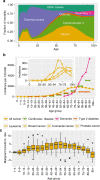Transcriptomic alterations during ageing reflect the shift from cancer to degenerative diseases in the elderly
- PMID: 29382830
- PMCID: PMC5790807
- DOI: 10.1038/s41467-017-02395-2
Transcriptomic alterations during ageing reflect the shift from cancer to degenerative diseases in the elderly
Erratum in
-
Publisher Correction: Transcriptomic alterations during ageing reflect the shift from cancer to degenerative diseases in the elderly.Nat Commun. 2019 May 31;10(1):2459. doi: 10.1038/s41467-019-10559-5. Nat Commun. 2019. PMID: 31150008 Free PMC article.
Abstract
Disease epidemiology during ageing shows a transition from cancer to degenerative chronic disorders as dominant contributors to mortality in the old. Nevertheless, it has remained unclear to what extent molecular signatures of ageing reflect this phenomenon. Here we report on the identification of a conserved transcriptomic signature of ageing based on gene expression data from four vertebrate species across four tissues. We find that ageing-associated transcriptomic changes follow trajectories similar to the transcriptional alterations observed in degenerative ageing diseases but are in opposite direction to the transcriptomic alterations observed in cancer. We confirm the existence of a similar antagonism on the genomic level, where a majority of shared risk alleles which increase the risk of cancer decrease the risk of chronic degenerative disorders and vice versa. These results reveal a fundamental trade-off between cancer and degenerative ageing diseases that sheds light on the pronounced shift in their epidemiology during ageing.
Conflict of interest statement
The authors declare no competing financial interests.
Figures





Similar articles
-
Aging and age-related diseases--from endocrine therapy to target therapy.Mol Cell Endocrinol. 2014 Aug 25;394(1-2):115-8. doi: 10.1016/j.mce.2014.07.005. Epub 2014 Jul 16. Mol Cell Endocrinol. 2014. PMID: 25038521 Review.
-
Ageing as a risk factor for neurodegenerative disease.Nat Rev Neurol. 2019 Oct;15(10):565-581. doi: 10.1038/s41582-019-0244-7. Epub 2019 Sep 9. Nat Rev Neurol. 2019. PMID: 31501588 Review.
-
A human tissue-specific transcriptomic analysis reveals a complex relationship between aging, cancer, and cellular senescence.Aging Cell. 2019 Dec;18(6):e13041. doi: 10.1111/acel.13041. Epub 2019 Sep 27. Aging Cell. 2019. PMID: 31560156 Free PMC article.
-
Genetic architecture of epigenetic and neuronal ageing rates in human brain regions.Nat Commun. 2017 May 18;8:15353. doi: 10.1038/ncomms15353. Nat Commun. 2017. PMID: 28516910 Free PMC article.
-
Increased neurodegeneration during ageing in mice lacking high-affinity nicotine receptors.EMBO J. 1999 Mar 1;18(5):1235-44. doi: 10.1093/emboj/18.5.1235. EMBO J. 1999. PMID: 10064590 Free PMC article.
Cited by
-
Molecular Signatures of Neurodegenerative Diseases Identified by Proteomic and Phosphoproteomic Analyses in Aging Mouse Brain.Mol Cell Proteomics. 2024 Sep;23(9):100819. doi: 10.1016/j.mcpro.2024.100819. Epub 2024 Jul 26. Mol Cell Proteomics. 2024. PMID: 39069073 Free PMC article.
-
Nonlinear DNA methylation trajectories in aging male mice.Nat Commun. 2024 Apr 9;15(1):3074. doi: 10.1038/s41467-024-47316-2. Nat Commun. 2024. PMID: 38594255 Free PMC article.
-
voyAGEr, a free web interface for the analysis of age-related gene expression alterations in human tissues.Elife. 2024 Mar 28;12:RP88623. doi: 10.7554/eLife.88623. Elife. 2024. PMID: 38546191 Free PMC article.
-
Comprehensive transcriptome analysis reveals altered mRNA splicing and post-transcriptional changes in the aged mouse brain.Nucleic Acids Res. 2024 Apr 12;52(6):2865-2885. doi: 10.1093/nar/gkae172. Nucleic Acids Res. 2024. PMID: 38471806 Free PMC article.
-
Acetylcholinesterase enzyme among cancer patients a potential diagnostic and prognostic indicator a multicenter case-control study.Sci Rep. 2024 Mar 1;14(1):5127. doi: 10.1038/s41598-024-55604-6. Sci Rep. 2024. PMID: 38429330 Free PMC article.
References
Publication types
MeSH terms
LinkOut - more resources
Full Text Sources
Other Literature Sources
Medical

